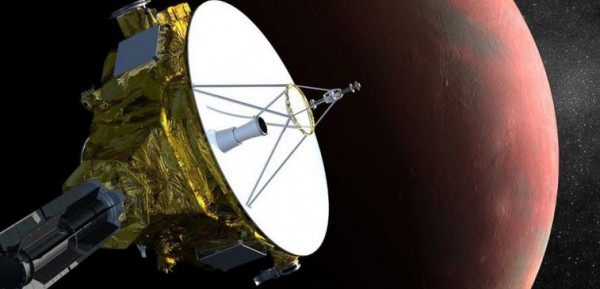After Nine Years, New Horizons is Finally at Pluto
| Marco Foronda | | Dec 02, 2014 06:47 AM EST |
(Photo : NASA) An artist's drawing of the New Horizons spacecraft as it approaches Pluto.
NASA's New Horizons spacecraft is set to fully awaken from its final hibernation period on December 6 after a nine-year voyage to Pluto.
Once New Horizons awakens on December 6, it will transmit radio signals to mission control center located at the Johns Hopkins University Applied Physics Laboratory in Maryland. The spacecraft will send a message to Earth confirming it remains operational an hour-and-a-half after it awakes. It will take four hours for its message to reach Earth, however.
Like Us on Facebook
It's scheduled to come to within 6,200 miles from the surface of Pluto on July 14, 2015, the closest approach to the planet by any man-made spacecraft.
The mission is man's first visit beyond Neptune's orbit and into the Kuiper Belt, which is home to Pluto and thousands of objects that have not yet been identified, according to website Spaceflight Now.
"This is the first look at this new zone of rocky, icy planets. This is what New Horizons is supposed to do," said Michael Buckley, a public information officer for John Hopkins University Applied Physics Laboratory to ABC News.
New Horizons is some 2.9 billion miles from our planet. It was launched in January 2006 as the payload of an Atlas V rocket. At the time of New Horizon's launch, Pluto was still considered a planet. Scientists, however, demoted Pluto to a dwarf planet later that year.
The spacecraft has been in and out of hibernation 18 times over the last nine years to conserve power. New Horizons transmits a beep once a week to tell scientists it's still alive.
Experts expect to get very clear images of Pluto once New Horizons gets within range of the planet in April 2015. They also expect to see the clearest view of the planet's terrain by May. New Horizons will send home the data throughout 2015 and most of 2016.
Scientists hope NASA will continue to fund and extend the mission further into the Kuiper Belt.
TagsPluto, dwarf planet, spacecraft, New Horizons, Spacecraft is About to Get Closer to Pluto, space exploration, NASA, solar system, Earth
©2015 Chinatopix All rights reserved. Do not reproduce without permission
EDITOR'S PICKS
-

Did the Trump administration just announce plans for a trade war with ‘hostile’ China and Russia?
-

US Senate passes Taiwan travel bill slammed by China
-

As Yan Sihong’s family grieves, here are other Chinese students who went missing abroad. Some have never been found
-

Beijing blasts Western critics who ‘smear China’ with the term sharp power
-

China Envoy Seeks to Defuse Tensions With U.S. as a Trade War Brews
-

Singapore's Deputy PM Provides Bitcoin Vote of Confidence Amid China's Blanket Bans
-

China warns investors over risks in overseas virtual currency trading
-

Chinese government most trustworthy: survey
-

Kashima Antlers On Course For Back-To-Back Titles
MOST POPULAR
LATEST NEWS
Zhou Yongkang: China's Former Security Chief Sentenced to Life in Prison

China's former Chief of the Ministry of Public Security, Zhou Yongkang, has been given a life sentence after he was found guilty of abusing his office, bribery and deliberately ... Full Article
TRENDING STORY

China Pork Prices Expected to Stabilize As The Supplies Recover

Elephone P9000 Smartphone is now on Sale on Amazon India

There's a Big Chance Cliffhangers Won't Still Be Resolved When Grey's Anatomy Season 13 Returns

Supreme Court Ruled on Samsung vs Apple Dispute for Patent Infringement

Microsoft Surface Pro 5 Rumors and Release Date: What is the Latest?










